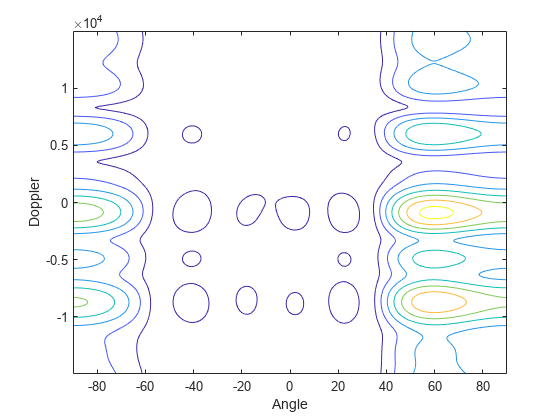phased.AngleDopplerResponse
Angle-Doppler response
Description
The AngleDopplerResponse object calculates
the angle-Doppler response of input data.
To compute the angle-Doppler response:
Define and set up your angle-Doppler response calculator. See Construction.
Call
stepto compute the angle-Doppler response of the input signal according to the properties ofphased.AngleDopplerResponse. The behavior ofstepis specific to each object in the toolbox.
Note
Starting in R2016b, instead of using the step method
to perform the operation defined by the System object™, you can
call the object with arguments, as if it were a function. For example, y
= step(obj,x) and y = obj(x) perform
equivalent operations.
Construction
H = phased.AngleDopplerResponse creates
an angle-Doppler response System object, H.
This object calculates the angle-Doppler response of the input data.
H = phased.AngleDopplerResponse( creates
angle-Doppler object, Name,Value)H, with each specified property
Name set to the specified Value. You can specify additional name-value
pair arguments in any order as (Name1,Value1,...,NameN,ValueN).
Properties
| Default: | ||||
| Signal propagation speed Specify the propagation speed of the signal, in meters per second, as a positive scalar. You can specify this property as single or double precision. Default: Speed of light | ||||
| System operating frequency Specify the operating frequency of the system in hertz as a positive scalar. The default value corresponds to 300 MHz. You can specify this property as single or double precision. Default: | ||||
| Source of PRF values Source of the PRF values for the STAP processor, specified as
Default: | ||||
| Pulse repetition frequency Specify the pulse repetition frequency (PRF) in hertz of the input signal as a positive
scalar. This property applies when you set the Default: | ||||
| Source of elevation angle Specify whether the elevation angle comes from the
Default: | ||||
| Elevation angle Specify the elevation angle in degrees used to calculate the angle-Doppler response as a
scalar. The angle must be between –90 and 90. This property applies when you set the
Default: | ||||
| Number of samples in angular domain Specify the number of samples in the angular domain used to calculate the angle-Doppler response as a positive integer. This value must be greater than 2. You can specify this property as single or double precision. Default: | ||||
| Number of samples in Doppler domain Specify the number of samples in the Doppler domain used to calculate the angle-Doppler response as a positive integer. This value must be greater than 2. You can specify this property as single or double precision. Default: |
Methods
| plotResponse | Plot angle-Doppler response |
| step | Calculate angle-Doppler response |
| Common to All System Objects | |
|---|---|
release | Allow System object property value changes |
Examples
Algorithms
References
[1] Guerci, J. R. Space-Time Adaptive Processing for Radar. Boston: Artech House, 2003.
Extended Capabilities
Version History
Introduced in R2011a
